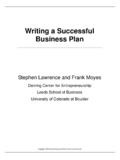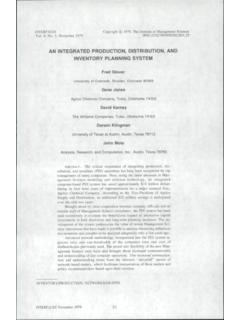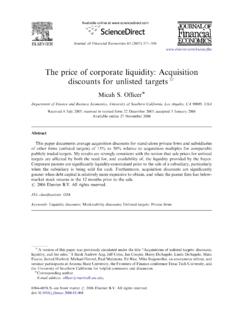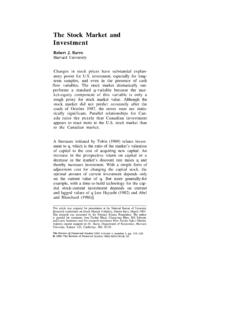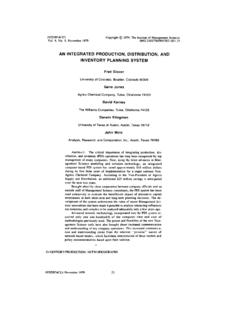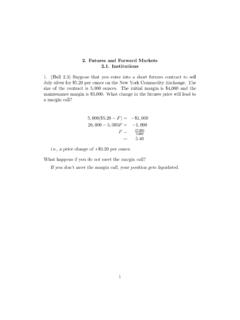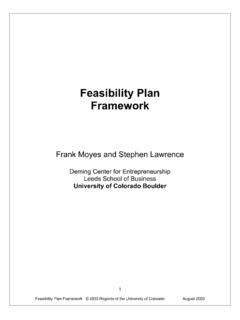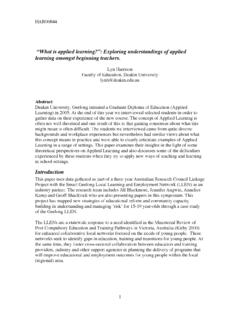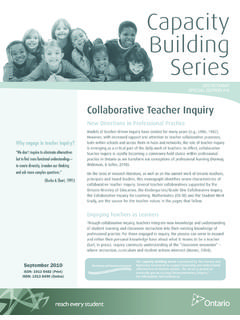Transcription of The Methodology of Organizational Diagnosis
1 CLAYTON P. ALDERFER. The Methodology of Organizational Diagnosis The purpose of Organizational Diagnosis is to establish the widely shared understanding of a system and, based on that understanding, to determine whether change is desirable. By stating and then maintaining that the initial work in the client system is Diagnosis , consultants provide clients with bases against which they can be held accountable. Organizational Diagnosis is considered as a recursive process. The topics considered in this article include entry, data collection, and feedback. The methods described here are self-correcting. For client systems who wish to learn, this Methodology provides the opportunity, if it is employed by consultants who have been thoroughly and appropriately trained. Organizational Diagnosis is a process based on behavioral science theory for publicly entering a human system, collecting valid data about human experiences with that system, and feeding that information back to the system to promote increased under- standing of the system by its members.
2 The purpose of Organizational Diagnosis is to establish a widely shared understanding of a system and, based on that under- standing, to determine whether change is desirable (Alderfer, 1976). Inevitably, the Organizational Diagnosis has a tendency to provoke change in a human system, but the perspective presented here distinguishes the aims of Diagnosis from those of planned change. According to the present view, diagnosticians attempt to change an organization only as far as is necessary to accomplish the purpose of diag- nosis. Otherwise they do not attempt to promote change, no matter how promising are the opportunities that seem to present themselves. This stance regarding change during Diagnosis combines an understanding of or- ganizational behavior with a value position regarding effective professional work in applied behavioral The work of Organizational Diagnosis may require the professional to work with the organization as a whole including organization-en- vironment relations, groups inside and outside the organization, and individuals whose lives are shaped by the organization and who in turn determine the nature of the or- ganization.
3 As a result, theory relevant to individuals, groups, and the organization as a whole is crucial to diagnostic work. Simply to survive, the professional must know how to develop and to maintain working relationships with the system and its major components. To complete the work of understanding a system, the professional must . know what data to obtain, how to collect it, and how to feed it back to the system to promote understanding. Because resistance to inquiry is a common human characteristic, diagnosticians are ill equipped if they cannot identify and work through resistances to their work. Therefore, without skills to effect change, diagnosticians' capacity to complete the diagnostic mission may be blocked by the very processes they are attempting to un- 1. Other perspectives on diagnosing organizations may be found in Argyris (1970), Levinson (1972), Mahler (1974), and Nadler (1977). Vol. 11, No.
4 3 June 1980 PROFESSIONAL PSYCHOLOGY 459. Copyright 1980 by the American Psychological Association, Inc. 0033-0175/80 3. UNDERSTANDING Organizational BEHAVIOR: Methodology OF Organizational Diagnosis . derstand. On the other hand, normally occurring client resistance cannot become part of the consultants' justification for acting unilaterally and arbitrarily in the face of that resistance. Consultants who aspire to excellence in their diagnostic work cannot achieve this goal without client cooperation. By stating and then maintaining that the initial work with a client system is Diagnosis , consultants provide clients with bases against which they (the consultants) can be held accountable. Consultants also provide a means for protecting themselves against excessive and unproductive demands by clients during Diagnosis . This approach sets limits on how consultants will use their skills and knowledge during Diagnosis and, in general, develops expectations about what consultants and clients can count on from one another during the diagnostic process.
5 Organizational Diagnosis as a Recursive Process Organizational Diagnosis proceeds in three orderly phases: entry, data collection, and feedback. These phases are well defined because there are a clearly observable be- ginning and end to each one. But the phases are also overlapping to a degree. The term recursive explains the nature of the overlap between each phase and the other two. Each phase has primary objectives, which determine the major thrust of the work in that phase, and secondary objectives, which relate the other two phases to whichever phase is being undertaken. Thus, there is some data collection and some feedback during entry, some entry and some feedback in data collection, and some entry and some data collection at feedback. ENTRY. The primary objectives of entry are to determine which units of the system (individual, group, and organization) will participate in the Diagnosis and to determine whether the client and consultant can reach agreement about their respective roles during data collection and feedback.
6 Entry begins with the first encounter between client and consultant and ends with a decision between client and consultant stating whether they can work together to complete the Diagnosis . Entry is also a time for data collection, as the consultant begins to learn about the client system through conversations, ob- servations, and documents. The close of entry, whether the decision is to terminate or to proceed with the next phases, provides the client with some feedback about how the consultant views the system (Alderfer, 1968b). People cannot be consultants to systems in which they are full-fledged members. CLAYTON P. ALDERFER, a Fellow oj"the American Psychological Association and of the Society for Applied Anthropology and a diplomate oj the American Board of Professional Psychology, is a professor at the Yale School of Organization and Management. He is the author of Existence, Relatedness, and Growth, and is co-author, with L.
7 Dave Brown, of Learning From Changing: Organizational Diagnosis and Development. He is presently co-editing Wiley's new series, Advances in Experimental Social Processes. THIS ARTICLE IS BASED on a more extended monograph-length treatment, Group Relations and Organizational Diagnosis , co-authored with L. David Brown, Robert E. Kaplan, and Ken K. Smith. REQUESTS FOR REPRINTS should be sent to Clayton P. Alderfer, Yale School of Organization and Management, Box 1A, New Haven, Connecticut 06520. 460 PROFESSIONAL PSYCHOLOGY Vol. 11, No. 3 June 1980. All individuals have vested interests in their own organizations. Even if individuals did not press their own interests, other members of the system would be unable to accept a consultant relationship from a peer, and the complete insider would be rendered ineffective as a result. Being at least partial outsiders, therefore, is part of the equipment of the Organizational consultants.
8 Without this role element, they cannot function effectively. Internal consultants, for example, can work in parts of a larger system where they have not been or currently are not members. But they cannot consult to their own groups, and they generally have a great deal of difficulty with parts of the system where they have recently been members. Being an outsider, while necessary for diagnostic work, is also a problematic feature of the consultant's role. Because consultants are outsiders, they can easily be prevented from understanding crucial elements of the system. Therefore, the consultant must establish some type of liaison system to manage the relationship between the consultant and those elements of the system where Diagnosis will take place. Depending on the nature of the system, the liaison system may be an individual, a series of individuals, or a group (Alderfer, 1977b). Whatever the state of an organization's boundaries before the entry process begins, it becomes more permeable during the time when client and consultant are exploring whether a complete Diagnosis should take place (Alderfer, 1976).
9 Outsiders, at least temporarily, are granted access to the organization an experience that inevitably generates threat for the organization and its members. Entry is like a natural ex- periment, providing consultants with an opportunity to observe how the system re- sponds when its boundaries become more permeable. As human beings themselves, consultants also experience the period of entry as a time of anxiety. In part this arises because the consultants are dealing with their potential acceptance or rejection by the client system. The more self-awareness and experience the consultants have, the less these feelings will interfere with their effec- tiveness during entry. In addition, the consultant will also experience the effects set off in the client system by the stress on the organization's boundaries. As an "au- thority" on Organizational behavior from outside, the consultant is likely to be the target for feelings that organization members have for authority figures inside their system.
10 The paradox of entry is that although it provides one of the best opportunities to observe Organizational dynamics, it does so under relatively poor conditions. Con- sultants' anxiety and their work of managing the client relationship to reach a decision about Diagnosis interfere with their making the most out of the data available at entry. Nonetheless, entry generally tells the organization's story very well. As a working heuristic, it is useful to assume that the major dynamics are all observable at entry, if the consultant is able to perceive them. The data available at entry can become the bases of working hypotheses for testing during data collection and feedback. As a matter of normal professional practice, it is useful to record systematically the hypotheses that are stimulated by entry events. This activity calls for the discipline of developing at least two hypotheses to explain each entry event deemed worthy of attention, an approach first advocated by Harry Stack Sullivan (1954) in connection with psychiatric interviews.


